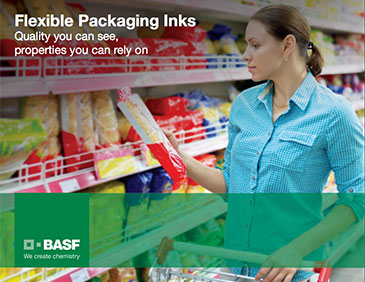Consumers buy food in packages, converters buy ink to print onto packaging materials, ink formulators develop inks that will perform to commercial printing standards. The science is continually evolving to keep up with business.
As the science around flexible packaging ink and material has changed, so have the expectations of consumers. Their growing demands for environmentally responsible packaging, coupled with tightening government regulations around allowable amounts of volatile organic compound (VOC) emissions, has flexible food packaging manufacturers hungering for sustainable solutions. But are those solutions ready to take the main stage in the industry?
The challenge with solvent-based
Solvent-based ink technology was developed using petrochemical and new manufacturing technologies that emerged after the Second World War. VOC's are inherently contained within the solvent-based inks and materials in differing amounts, depending on the make-up of the ink and the type of print process being used. During the drying process, VOC's convert to gases and are released into the atmosphere as a waste product, adversely impacting the print operator's health and lowering the quality of air in the environment.
Despite this fact, solvent-based inks and wrapping remain the most common type of materials in use today in the flexible packaging industry, making up 80 to 85 percent of the market.
"The solvent-based material printing process is a mature technology that performs really well in manufacturing machines. It moves through them at a very high rate of speed and it accepts ink and dries faster than other types of material," says Jaime Manon, Market Segment Manager, Flexible Packaging, BASF Corporation. "Currently, solvents offer a more affordable packaging solution than water-based inks and materials."
So what's driving the need to change?
The pressure is on
In an ongoing effort to reduce the build up of ground-level ozone caused by VOC's, EPA regulations governing VOC emissions are gradually tightening. These regulations apply to industries where the accumulation of the toxins would be enough to offer a significant threat to health and the environment.
When considering the potential impact of what packaging creation and disposal might have on the environment, consumers are changing their buying criteria priorities. Passive consumerism is a thing of the past and today's customers are front and center in shaping change in the packaging market. End-use consumers value more food packaging that takes the environment into account.
Manufacturers now have opportunity to capitalize on this consumer trend to tailor the science and ensure that it still drives business in a profitable and responsible direction.
Does the water-based alternative fit into that flow?
Weighing in on a water-based solution
Water-based inks and materials offer packaging solutions with substantially lower VOC profiles. But the challenge has been to develop water-based products that perform as well as solvent-based materials in a commercial application.
"Specifically for ink resins, we have seen printers and/or converters driving the need of reducing the VOC emissions in their printing presses and in their sites. We have also seen more openness to water-based inks for printing in flexible packaging applications," says Manon.
Water-based technologies, like BASF's proprietary self-crosslinking acrylic emulsions and PU dispersion methods, are working hard to meet performance standards set by their solvent counterparts. Although the technology has been slow to mature, water-based inks available today offer a competitive alternative to solvents.
However, getting converters to adopt the new technologies can be a different story.
Cultivating the conversion
As all converters may not be willing to jump right in, ink formulators need to engage in progressive tactics to nurture a wider acceptance of water-based inks.
Some effective ways Manon has found success in bridging the water-based gap between formulators and converters include:
Use mock-ups. Create packaging mock-up samples of flexible packages to give buyers an example of water-based technology on flexible films that they can actually hold in their hands. They can examine the quality and durability for themselves.
Get out there. Trade shows, technical conferences, magazine publications and other industry events allow ink formulators to make solid connections with converters and brand owners and to collect information they would likely not otherwise have.
Build strong relationships. Relationship building between the R&D, marketing teams and customers gives ink formulators insight into new types of technologies and equipment being used in their print processes.
Relationship building as a conversion tool is invaluable. "I think it's really important, because it's not only allowing us the opportunity to talk to our direct customers, but also to other players in the value chain," Manon explains. "When I go to a customer, I always try to understand what they are thinking, what they are seeing in the marketplace, and what their customers are asking them to do."
The ink bottle is half full
It's hard to keep everyone happy all of the time. Evolving to keep pace with demands of converters, governments and the end consumer can be a relentless pressure. However, the silver lining to this packaging cloud is that manufacturers now have an opportunity to use the demands as a data barometer for shaping the future. The solution is actually presenting itself; it's just a matter of getting there.
Want to learn more?
BASF offers ink formulators a broad portfolio of pigments, resins, resin solutions and formulation additives.
Download now
